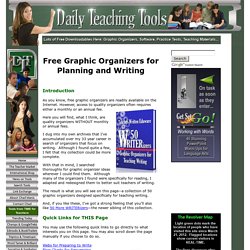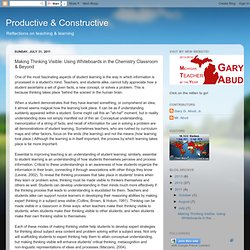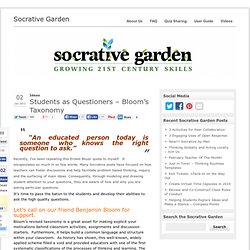

Random Picker. A Handy Chart Featuring 8 Ways to Do Formative Assessment. Formative assessment. Foodlabrubricslite. Free Graphic Organizers for Teaching Writing. Introduction As you know, free graphic organizers are readily available on the Internet.

However, access to quality organizers often requires either a monthly or an annual fee. Here you will find, what I think, are quality organizers WITHOUT monthly or annual fees. I dug into my own archives that I've accumulated over my 33 year career in search of organizers that focus on writing. With that in mind, I searched thoroughly for graphic organizer ideas wherever I could find them. The result is what you will see on this page--a collection of 50 graphic organizers designed specifically for teaching writing. And, if you like these, I’ve got a strong feeling that you’ll also like 50 More WRITERizers—the newer sibling of this collection.
Using Whiteboards in the Chemistry Classroom & Beyond. One of the most fascinating aspects of student learning is the way in which information is processed in a student's mind.

Teachers, and students alike, cannot fully appreciate how a student ascertains a set of given facts, a new concept, or solves a problem. This is because thinking takes place 'behind the scenes' in the human brain. When a student demonstrates that they have learned something, or comprehend an idea, it almost seems magical how the learning took place. It can be as if understanding suddenly appeared within a student. Some might call this an "ah-ha! " Essential to improving teaching is an understanding of student learning; similarly, essential to student learning is an understanding of how students themselves perceive and process information.
Each of these modes of making thinking visible help students to develop expert strategies for thinking about subject area content and problem solving within a subject area. Techniques References. Upgrade your KWL Chart to the 21st Century One of the take aways from the Curriculum Mapping Institute this past week was that it brought an upgrade to THE trusted KWL (Know, What to Know and Learned) Chart to the forefront.

It seems a no brainer…one of those things… “I should have thought about it”… So what is this upgrade all about? An “H” snuck into the Acronym! What does this “H” stand for”? Why is this an upgrade for the 21st century? I started out by searching Google, which immediately wanted to correct my search term and showed me the traditional “KWL chart” results. The top search results turned out mostly downloadable files for templates, which was quiet interesting as there were several explanations in these tutorials what the “H” could stand for: Using Quizzes to Promote Student Engagement and Collaboration. January 26, 2012 By: Audrey Deterding, Ph.D. in Teaching and Learning Quizzes are standard in many college classrooms, and determining how to best use this learning format generates a variety of discussion and suggestions.

I, too, continue to search for ways to inspire the often dull quiz routine. In an effort to bring new strategies to the classroom and keep student engagement high, I have recently discovered a successful strategy that encourages a sense of community in class, offers students an opportunity to engage in collaborative learning, and motivates students to come to class prepared. Let me explain how it works. First, the chalkboard or whiteboard in the classroom becomes what I call a “community space.” Whatever information is put up on the board can be used by the rest of the class on the quiz. When I first introduced this idea to the class, there were some reservations, especially about my being “fair” when selecting the students. Recent Trackbacks.
Students as Questioners – Bloom’s Taxonomy. “An educated person today is someone who knows the right question to ask.”

Recently, I’ve been repeating this Ernest Boyer quote to myself. It encapsulates so much in so few words. Many Socrative posts have focused on how teachers can foster discussions and help facilitate problem based thinking, inquiry and the surfacing of main ideas. Consequently, through modeling and drawing student attention to your questions, they are aware of how and why you are asking particular questions. It’s time to pass the baton to the students and develop their abilities to ask the high quality questions. Let’s call on our friend Benjamin Bloom for support. Bloom’s revised taxonomy is a great asset for making explicit your motivations behind classroom activities, assignments and discussion starters. Developing an Understanding of Bloom’s Taxonomy Socrative Solution: Utilize Short Response (SR), Multiple Choice (MC) and True/False (TF) Formative assessments. Formative assessment. 23 Formative Digital Resources. Welcome to a series that is must read for any PBL or STEM educator.

It will include information to reflect and build upon as you consider both PBL and STEM. Best of all, it will finish with over 50 amazing resources you will want to investigate. First, to ensure you do not miss one of these valuable posts or other resources covering PBL, Digital Curriculum, Web 2.0, STEM, 21st century learning, and technology integration please sign up for 21centuryedtech by email or RSS. As always, I invite you to follow me on twitter (@mjgormans).